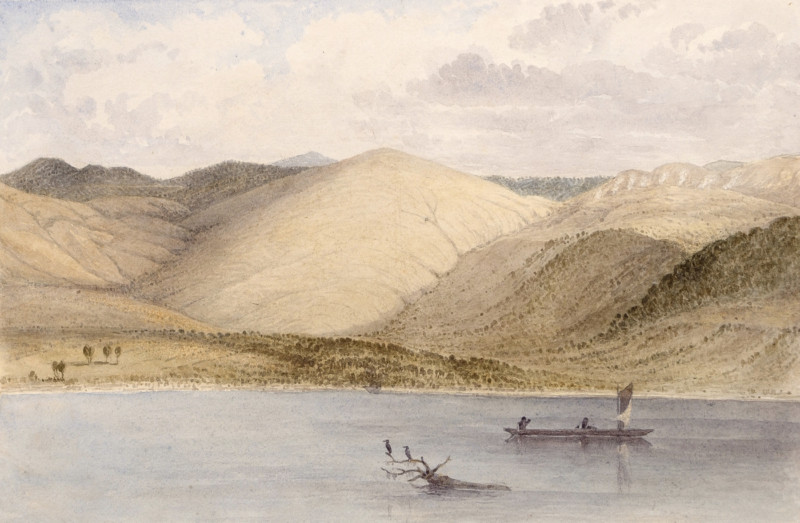KINDER, John;
Te Rapa, Lake Taupō, December 28, 1861: The Scene of Te Heuheu's Death, 1846
c.1886
Watercolour on paper
210 x 295mm

This is the twenty-eighth work from the Ferrier-Watson album of watercolours by John Kinder. The album originally comprised 32 works. It was handed down through Kinder’s family, eventually passing into the care of his great-grandson, Dr J. K. Ferrier-Watson of Te Awamutu. In 1969, Ferrier-Watson showed the album to the president of the Waikato Society of Arts, Rob Gardiner, who encouraged him to lend it to the Waikato Art Gallery (later Waikato Museum Te Whare Taonga o Waikato), then being operated by the Society, for safe-keeping and exhibition.
An exhibition was duly prepared by the director of the Gallery, Gordon H. Brown, and the album was disbound to facilitate display. In the course of his research, Brown noticed that several of the works were on sheets of paper watermarked with the date 1886. He deduced that the various captions on the works gave the dates the artist visited or sketched the locations, rather than the dates he produced the paintings. It is probable that all the watercolours from the album were painted about the same time, in or shortly after 1886.
The exhibition opened at the Gallery in 1970 and then toured for a period. The works remained on long-term loan for a number of years but were eventually recalled. In 2003, 30 of the watercolours were sold to the Fletcher Trust by Russell Catley, who likely acquired them from Ferrier-Watson (certainly, Catley was connected with Te Awamutu). They were immediately placed on long-term loan to Auckland Art Gallery Toi o Tāmaki, where they were exhibited in 2004 as part of the landmark John Kinder’s New Zealand, curated by the late Ron Brownson.
For further information, see Michael Dunn, Lakes and Shores and Mountain Crags: The Ferrier-Watson Album of Watercolours by John Kinder (Auckland: Kinder House Society, 2007).
The following text was written for Te Huringa/Turning Points.
Jo Diamond
Kinder’s watercolour of Te Rapa is typical of his well-ordered painting style, resonating with his formal artistic education in England. Like many other paintings by this prolific artist, it is also a frozen account of one of many landscape scenes he beheld during his long life in Aotearoa. These scenes are predominantly rural and often devoid of human figures. This painting is no exception with hilly smoothed-off terrain dominating its composition. An incidental waka floats on a placid lake surface. However, it is the painting’s title that indicates another facet of Kinder’s life: his knowledge of and interest in Māori people.
This painting’s title, referring to a highly esteemed tupuna of Ngāti Tūwharetoa, could also point to Kinder’s own religiosity. With its posthumous (by some 15 years) reference to the death of the Tūwharetoa rangatira, Te Heuheu Tūkino II, Mananui, in Māori eyes this painting’s title pays homage, whether the artist intended so or not, to the mana of a man, his people, and the land that sustained them. Te Heuheu’s mana, imprinted into the whenua, thus prevails beyond his death, thanks in part to this painting. Kinder provides a hint of the landslide that brought Te Heuheu’s death so swiftly: the central hill appears paler and newer than the others. The painting does not limit its subject to that tragedy alone; in broader terms it points to the long history of the Ngāti Tūwharetoa rohe in the Taupō region.
Exhibition History
John Kinder’s New Zealand, curated by Ron Brownson, Auckland Art Gallery Toi o Tāmaki, 28 February to 9 May 2004
The Ferrier-Watson Collection of Watercolours by John Kinder, Waikato Art Gallery (later Waikato Museum Te Whare Taonga o Waikato), Kirikiriroa Hamilton, 1970 (toured)
Provenance
2003–
Fletcher Trust Collection, purchased from R. H. and J. L. Catley, 2003, on long-term loan to Auckland Art Gallery Toi o Tāmaki (L2003/8/24) from 2003
?–?
Collection of the artist’s great-grandson, Dr J. K. Ferrier-Watson, Te Awamutu, on long term loan to Waikato Art Gallery (later Waikato Museum Te Whare Taonga o Waikato), Kirikiriroa Hamilton, from about 1969
–?
Collection of the artist and his family

